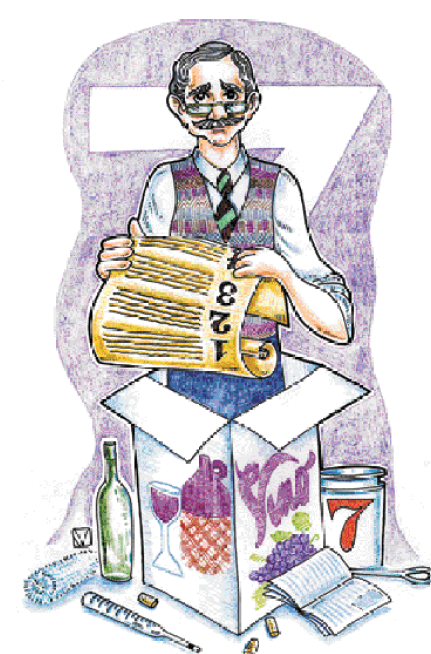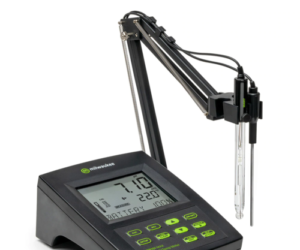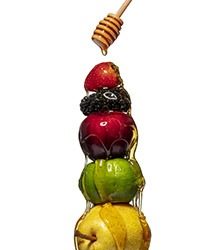 If you want your kit wine to turn out great every time, and avoid the pitfalls that crop up time and again, here are the seven highly fermentative habits you need to follow.
If you want your kit wine to turn out great every time, and avoid the pitfalls that crop up time and again, here are the seven highly fermentative habits you need to follow.
Habit 1: Read the Instructions
Kit wine manufacturers don’t randomly change the process of winemaking for their kits. However, when faced with a changed technology — such as new fining agents, different strains of yeast or a different level of solids in the raw materials — they have to alter the procedures to ensure the wine turns out correctly. Even if you’re an experienced winemaker, and you made the very same kit a short time ago, always read the instructions again — they may have changed without your notice. This is especially important in regards to racking, stirring and fining procedures, which are the aspects most likely to change.
Habit 2: Keep it Clean
Wine is food. When you’re preparing food at home, you use a clean cutting board, wipe the counter, wash your hands and use clean plates and cutlery. Now imagine your dinner had to sit a month, or even six weeks, before it was ready to eat. Unless your clean-up and preparation was intensely sanitary, your food would be spoiled long before you could eat. The same goes for wine. Unless your winemaking equipment is always kept spotless and sanitized, you’re giving environmental bacteria up to a month and a half to chow down on your wine!
Remember, cleaning and sanitation are two different things. Cleaning is removing visible dirt and residue from your equipment. Sanitizing is treating that equipment with a chemical that will prevent the growth of spoilage organisms. Everything that comes in contact with your wine must be clean and properly sanitized, from the thermometer to the carboy, from the siphon hose to the bung and airlock.
Habit 3: Write it Down
Winemaking is like any other hobby — you’ll be better able to duplicate your successes and avoid your failures by keeping records of both. You can either jot these in the spaces provided right on the instruction sheets, or get a notebook that you can keep in your winemaking area. Ideally, you should record: the date and time you started your fermentation and the type of kit, your measurements (specific gravity, temperature) and the temperature of your fermentation area.
Habit 4: Be Full of it
One thing that is crucial to the success of a wine kit is starting it out at the correct volume. Virtually all dry table wine kits start off at six gallons (23 L). Dessert wines are usually three gallons (11.5 L). On day one, you need to add the correct amount of water to make that full, 6-gallon (23-L) volume. The consequences of over-diluting are weak-tasting, low-alcohol wine that may not keep well.
The potential consequences of under-diluting are subtler and potentially more harmful. First, unless corrected, under-dilution will make a harsh, unbalanced wine. It will have a high alcohol content, but no finesse. Certainly the wine will not taste the way it is described in the manufacturer’s literature.
The wine will also take longer to ferment and may not clear well. Starting off at the correct volume requires the use of a primary fermenter with at least an 8-gallon (30-L) capacity. This is to allow room for foaming during primary fermentation, which in a wine kit can be astonishingly vigorous.
Habit 5: Stir the Pot
Wine kits generally contain the admonition “stir vigorously” somewhere within the text of the instructions. Vigorous stirring is needed on day one. This is because the juice and concentrate are viscous and don’t mix easily with water. Even if it seems that dumping the contents of the bag into the primary with the water has done the job, it hasn’t. The juice lies on the bottom of the pail with a layer of water on top. This not only throws off any gravity readings, it also overworks the yeast. The yeast may get through the diluted top layer all right, but underneath it can’t ferment the high-sugar, unmixed juices. The yeast might even quit early, leaving underfermented wine.
Vigorous stirring is also needed when it comes time to stabilize and fine the wine. The stirring has to drive off all of the CO2 the wine accumulated during fermentation. This is because the dissolved gas will attach to the fining agents, preventing them from settling out. You need to stir hard enough to make the wine foam and keep stirring until it stops foaming.
Habit 6: Temperature Control
One factor that frequently causes problems with wine kits is using the wrong temperature, or varying temperature ranges during fermentation or fining. Kit instructions tell you to ferment your wine within a specific temperature range, typically 68–78 °F (18–24 °C). Kit yeast prefer this temperature range as it provides a good compromise between optimum growth and ester (flavor compound) production. Yeast cells certainly do not like drastic temperature fluctuations.
This is another situation where kit instructions are different from grape winemaking techniques. In commercial wineries, some white wines are fermented cooler than this, sometimes below 55 °F (12 °C). Again, commercial wineries have the luxury of taking a year or so before they bottle their wines. For the home winemaker though, if the fermentation area is too cool, the wine will ferment very slowly and you’ll be stuck with fizzy, unfineable wine.
Temperature range is one thing, but temperature fluctuations are another kettle of oysters. Winemaking yeast is actually a fussy little milquetoast of a fungus. Too many cycles of hot and cold and it will decide that the environment is too hostile and it will go dormant. This will extend the length of your fermentation — and may even stop it altogether.
Habit 7: Magic Ingredient
Have you ever wondered if there was a magic ingredient that you could add to your wine to make things easier? The truth is, there actually is such a thing — it is called time. You see, wine kits are ready to bottle in 28 or 45 days — they’re not ready to drink! For most whites, and virtually all reds, at least six months is needed to smooth out the wine and allow it to express mature character. Heavy reds will continue to improve for at least a year, rewarding your patience with a delicious bouquet. So, the old kit winemaker’s secret to making great homemade wines: Add the magic ingredient of time and let it work its magic!







